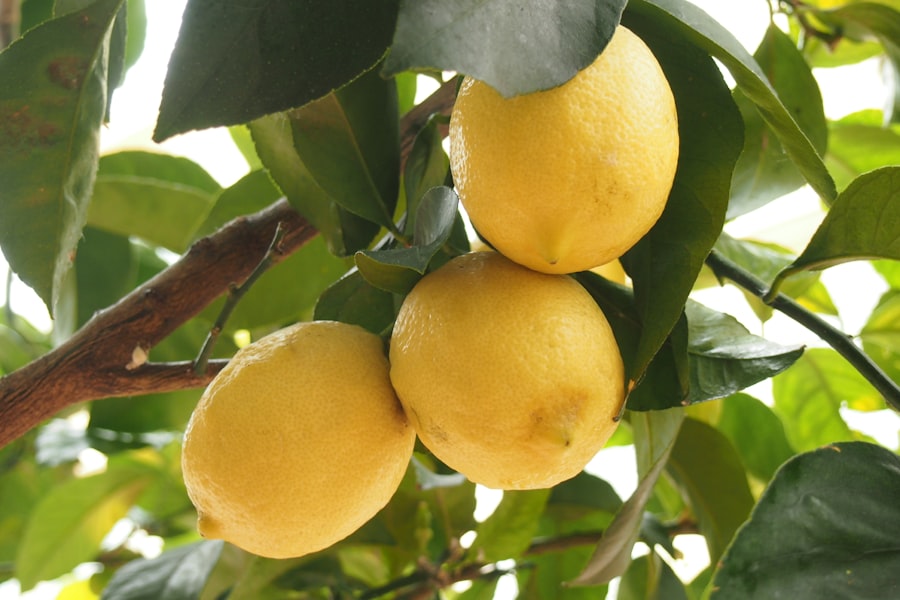When to Trim Your Lemon Tree for Optimal Growth

Lemon tree trimming is an essential practice for maintaining the health and productivity of your lemon tree. Trimming involves the removal of dead, damaged, or overgrown branches to promote healthy growth and fruit production. By trimming your lemon tree regularly, you can ensure that it remains in optimal condition and continues to provide you with an abundance of delicious lemons.
Key Takeaways
- Trimming your lemon tree is important for its health and productivity.
- Benefits of trimming include increased fruit production, improved tree structure, and disease prevention.
- Signs that your lemon tree needs trimming include overgrown branches, dead or damaged branches, and crowded growth.
- Timing of trimming should be done during the dormant season, typically in late winter or early spring.
- Tools required for trimming include pruning shears, loppers, and a pruning saw.
Benefits of Trimming Your Lemon Tree
There are numerous benefits to trimming your lemon tree. Firstly, trimming can significantly increase fruit yield. By removing excess branches and foliage, you allow more sunlight and air circulation to reach the remaining branches, which promotes better fruit development. Additionally, trimming helps to redirect the tree’s energy towards fruit production rather than maintaining unnecessary branches.
Secondly, trimming improves the overall health and appearance of your lemon tree. Removing dead or damaged branches prevents the spread of disease and infestations by pests. Trimming also helps to shape the tree, giving it a more aesthetically pleasing form. A well-trimmed lemon tree not only looks beautiful but also functions optimally.
Signs that Your Lemon Tree Needs Trimming
There are several signs that indicate your lemon tree is in need of trimming. One of the most obvious signs is overgrown branches. If the branches are extending beyond the desired size or interfering with nearby structures, it’s time to trim them back.
Another sign is dead or damaged branches. These branches not only detract from the appearance of the tree but can also pose a risk if they fall. Removing them will prevent further damage and potential hazards.
Lastly, a crowded canopy is a sign that your lemon tree needs trimming. When the branches become too dense, they can block sunlight and air circulation, leading to poor fruit development and increased susceptibility to disease.
Timing of Lemon Tree Trimming
| Timing of Lemon Tree Trimming | Benefits | Drawbacks |
|---|---|---|
| Winter | Stimulates new growth, improves fruit quality, and increases yield | May expose tree to frost damage if done too early in the season |
| Spring | Removes dead wood, promotes flowering, and enhances fruit production | May interfere with pollination if done during blooming period |
| Summer | Controls tree size, prevents sunburn, and reduces water stress | May reduce fruit production if done too late in the season |
| Fall | Prevents disease, removes pests, and prepares tree for winter dormancy | May delay or inhibit fruit ripening if done too close to harvest time |
Timing is crucial when it comes to lemon tree trimming. The best time to trim your lemon tree is during the dormant season, which is typically in late winter or early spring. Trimming during this time allows the tree to recover and heal before the growing season begins.
It’s important to avoid trimming your lemon tree during extreme weather conditions, such as during periods of frost or high heat. Trimming during these times can cause stress to the tree and hinder its ability to recover.
Tools Required for Lemon Tree Trimming
To effectively trim your lemon tree, you will need a few essential tools. These include pruning shears, loppers, a pruning saw, and a ladder or pole pruner for reaching higher branches. It’s important to use sharp and clean tools to ensure clean cuts and minimize the risk of disease transmission.
Sharp tools make clean cuts that heal faster and reduce the risk of infection. Clean tools prevent the spread of diseases from one branch to another. Before using your tools, make sure to sanitize them with a solution of one part bleach to nine parts water.
Steps to Trim Your Lemon Tree

Trimming your lemon tree can be done in a few simple steps. First, start by removing any dead or damaged branches. Use pruning shears or loppers to make clean cuts just above the branch collar, which is the swollen area where the branch meets the trunk.
Next, thin out any overcrowded branches by selectively removing some of them. This will allow more sunlight and air circulation to reach the remaining branches, promoting better fruit development.
Lastly, shape the tree by trimming back any branches that are extending beyond the desired size or interfering with nearby structures. Make sure to maintain a balanced shape by trimming evenly on all sides.
Pruning Techniques for Optimal Growth
Different pruning techniques should be used for different types of branches on your lemon tree. For smaller branches, use pruning shears or loppers to make clean cuts just above a bud or lateral branch. This will encourage new growth in the desired direction.
For larger branches, use a pruning saw to make a three-step cut. First, make an undercut about 12 inches away from the trunk. Then, make a top cut just outside the undercut. Finally, make a final cut just outside the branch collar to remove the branch.
Proper technique is crucial for the health and fruit production of your lemon tree. Make sure to make clean cuts at the appropriate locations to promote healing and prevent disease.
Precautions to Take While Trimming Your Lemon Tree
While trimming your lemon tree, it’s important to take certain precautions to avoid injury and protect the tree from damage. Always wear protective gloves and eyewear to protect yourself from thorns and debris. Use a sturdy ladder or pole pruner when reaching higher branches to prevent falls.
When trimming, be mindful of the tree’s natural shape and avoid removing too many branches at once. Over-pruning can stress the tree and hinder its ability to recover. It’s better to trim gradually over time rather than all at once.
Common Mistakes to Avoid While Trimming Your Lemon Tree
There are several common mistakes that should be avoided while trimming your lemon tree. One of the most common mistakes is over-pruning. Removing too many branches can weaken the tree and reduce its ability to produce fruit. It’s important to strike a balance between removing excess branches and maintaining a healthy structure.
Another mistake is using improper technique when making cuts. Improper cuts can lead to slow healing and increased risk of disease. Make sure to make clean cuts just above the branch collar or bud to promote healing and prevent infection.
Lastly, neglecting to clean your tools can lead to the spread of diseases from one branch to another. Always sanitize your tools before and after use to minimize the risk of disease transmission.
Enjoying the Fruits of Your Labor
In conclusion, lemon tree trimming is a vital practice for maintaining the health and productivity of your lemon tree. By trimming regularly, you can increase fruit yield, improve tree health and appearance, and prevent disease and pest infestations.
With the right tools and proper technique, trimming your lemon tree can be a rewarding and enjoyable task. Take the time to assess your tree’s needs and trim accordingly. With a little effort and care, you can enjoy the fruits of your labor with a healthy and fruitful lemon tree.
If you’re looking for expert advice on the best time to trim a lemon tree, look no further than Lawn World. Their comprehensive website offers a wealth of information on all things related to lawn care and gardening. In fact, they have an entire section dedicated to citrus trees, including an article specifically on the best time to trim lemon trees. To learn more, check out their informative article here. And if you’re interested in exploring other topics related to lawn care and gardening, be sure to visit their sitemap here.
FAQs
What is the best time to trim a lemon tree?
The best time to trim a lemon tree is during the late winter or early spring, before the tree starts to produce new growth.
Why is late winter or early spring the best time to trim a lemon tree?
Late winter or early spring is the best time to trim a lemon tree because the tree is dormant during this time, which means it is not actively growing. Trimming during this time will not harm the tree and will promote healthy growth in the spring.
What should I look for when trimming a lemon tree?
When trimming a lemon tree, look for dead or diseased branches, as well as branches that are crossing or rubbing against each other. You should also look for branches that are growing too close to the ground or are growing straight up.
How much should I trim off my lemon tree?
When trimming a lemon tree, you should only remove about 20% of the tree’s total foliage. Removing too much foliage can harm the tree and reduce its ability to produce fruit.
What tools do I need to trim a lemon tree?
To trim a lemon tree, you will need a pair of sharp pruning shears, a pruning saw, and a ladder if the tree is tall.
Can I trim my lemon tree during the summer?
It is not recommended to trim a lemon tree during the summer, as this is when the tree is actively growing and producing fruit. Trimming during this time can harm the tree and reduce its ability to produce fruit.



